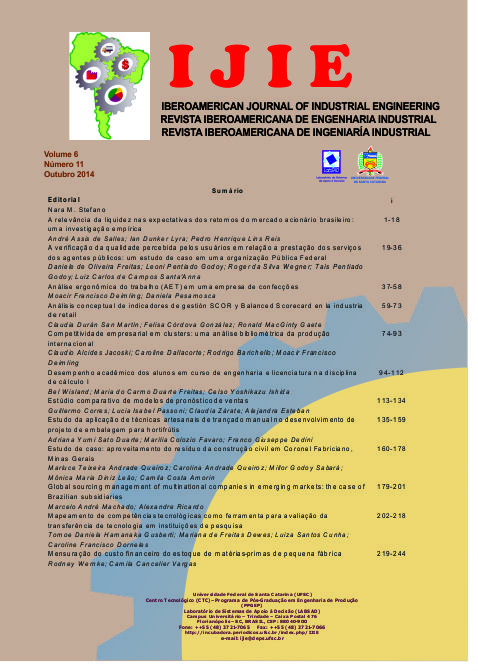System dynamics simulation model for decision making in retailer selection
Palavras-chave:
System dynamics, Simulation, Retailer selectionResumo
Simulation models are becoming increasingly popular in the analysis of important policy issues including global warming, population dynamics, energy systems, and urban planning. The usefulness of these models is predicated on their ability to link observable patterns of behaviour of a system to micro-level structures. This paper argues that structural validity of a simulation model -right behaviour for the right reasons- is a stringent measure to build confidence in a simulation model regardless of how well the model passes behaviour validity tests. That leads to an outline of formal structural validity procedures available but less explored in system dynamics modelling ‘repertoire’. An illustration of a set of six tests for structural validity of both system dynamics and agent-based simulation models follows. Finally, some conclusions on the increased appeal for simulation models for policy analysis and design are presented.
10.13084/2175-8018/ijie.v6n11p367-382
Key words: System Dynamics, Simulation, Retailer selectionReferências
Dobson Paul, W., Michael Waterson and Stephen Davies, W. 2003. “The Patterns and Implications of Increasing Concentration in European Food Retailingâ€, Journal of Agricultural Economics, Vol. 54, No. 1, pp. 111-125.
Dunn, R. and Wrigley, N. 1984. “Store loyalty for grocery products: an empirical studyâ€, Area, Vol. 16, No. 4, pp. 307-314.
Enis, B.M. and Paul, G.W. 1970. “Store loyalty as a basis for market segmentationâ€, Journal of Retailing, Vol. 46 No. 3, pp. 42-56.
Ernst and Young. 2006.“The Great Indian Retail Storyâ€, Ernst & Young’s report, April, 2006.
GOI. 2009 “Ninetieth Report of the Committee on the Foreign and Domestic Investment in Retail Sectorâ€, Government of India, Department Related Parliamentary Standing Committee on Commerce, New Delhi, May 04, 2009.
GRDI. 2007. “Annual Global Retail Development Indexâ€, AT Kearney, 2009, [Retrieved June 4, 2007, from http://www.foodroutes.org/whycare3.jsp ]
Hair, J. F., Black, B., Babin, B., Anderson, R. E. and Tatham, R. L. 2006. Multivariate Data Analysis (6 ed.). Prentice Hall, Delhi.
Hu, D., Reardon, T., Rozelle, S., Timmer, P. and Wang, H. 2004. “The Emergence of Supermarkets with Chinese Characteristics: Challenges and Opportunities for China’s Agricultural Developmentâ€, Development Policy Review, Vol. 22, No. 4, pp. 557-86.
IBEF. 2008. “Retail Industry, update April-June 2008â€, Indian Brand and Equity Foundation (IBEF), 2008 [Retrieved October 1, 2008 from www.ibef.org ]
Jaju, R. 2007. “Organised food retailing can increase rural income, cut inflation - Resultant increase in rural spending can boost GDPâ€, CRISIL Research, Mumbai,.
Mahmodi, Jafar, and Mohamad Hosein Minaee. 2010. "Using System Dynamics to Model Rod Bar Supply Chain in Iranian Market." International Journal of Industrial Engineering & Production Research, Vol. 21, No. 3, pp. 129-135.
McGoldrick, P.J. and Andre, E. 1997. “Consumer misbehaviour: promiscuity or loyalty in grocery shoppingâ€, Journal of Retailing and Consumer Services, Vol. 4, No. 2, pp. 73-81.
Pingali, P. L. and Rosegrant, M. W. 1995. “Agricultural Commercialization and Diversification: Processes and Policiesâ€, Food Policy, Vol. 20,
No. 3, pp. 171-185.
Pysarchik, D.T., Chung, J.E. and Plank, L.F. 1999. “Indian market has food for thoughtâ€, Marketing News, 19 July.
Reardon, T. and Berdegué, J. A. 2006. “The Retail-Led Transformation of Agrifood Systems and its Implications for Development Policiesâ€, World Development Report, Ottawa.
Reardon, T. and Timmer, C.P. 2007. “Transformation of Markets for Agricultural Output in Developing Countries Since 1950: How Has Thinking Changed?â€, Volume 3 Handbook of Agricultural Economics, pp. 2807-2855.
Reardon, T., Codron, J., Busch, L., Bingen, J. and Harris, C. 2003. “Global Change in Agri-food Grades and Standards: Agribusiness Strategic Responses in Developing Countries. International Food and Agribusiness Management Review, Vol. 2, No. 3, pp. 195-205.
Shu-Shian Ling, Ho Jung Choo and Dawn Thorndike Pysarchik. 2004. “Adopters of new food products in Indiaâ€, Marketing Intelligence & Planning, Vol. 22 No. 4, pp. 371-391.
UNDP. 2005. “World Employment Report 2004-05â€, United Nation Development Programme.
Uva Wen-fei. 2000. “An Analysis of Marketing Needs and Strategies in the Vegetable Industry in New York and Marketing Programs at Cornellâ€, Department of Agricultural, Resource, and Managerial Economics, Cornell University, Ithaca, New York.
World Bank. 2009. “World Development Report 2008: Agriculture for Developmentâ€, World Bank Reports, Washington D.C. and Published October 16, 2009.
Downloads
Publicado
Como Citar
Edição
Seção
Licença
Os artigos publicados são de propriedade do IJIE – Iberoamerican Journal of Industrial Engineering, Revista Iberoamericana de Engenharia Industrial, Revista Iberoamericana de Ingeniería Industrial. Os autores são os responsáveis pelos conteúdos dos artigos. O IJIE não se responsabiliza ou endossa as opiniões emitidas pelos autores dos textos publicados, salientando que as opiniões são de exclusiva responsabilidade dos autores.
O periódico se reserva o direito de introduzir alterações no original, visando a manter a homogeneidade e a qualidade da publicação, respeitando, no entanto, o estilo e as opiniões dos autores. Essas alterações serão editoriais (correções gramaticais e adequações estilísticas) e não substanciais, de forma que não modifiquem o sentido do texto. As provas finais não serão enviadas aos autores, sendo o artigo publicado com os ajustes necessários.
Conforme citado neste site, no item “Caráter do IJIE”, os artigos são de uso gratuito, com atribuições próprias em aplicações educacionais e não-comerciais. Uma nova publicação do mesmo texto, de iniciativa de seu autor ou de terceiros, fica sujeita à expressa menção da precedência de sua publicação neste periódico, citando-se a edição e a data dessa publicação.

